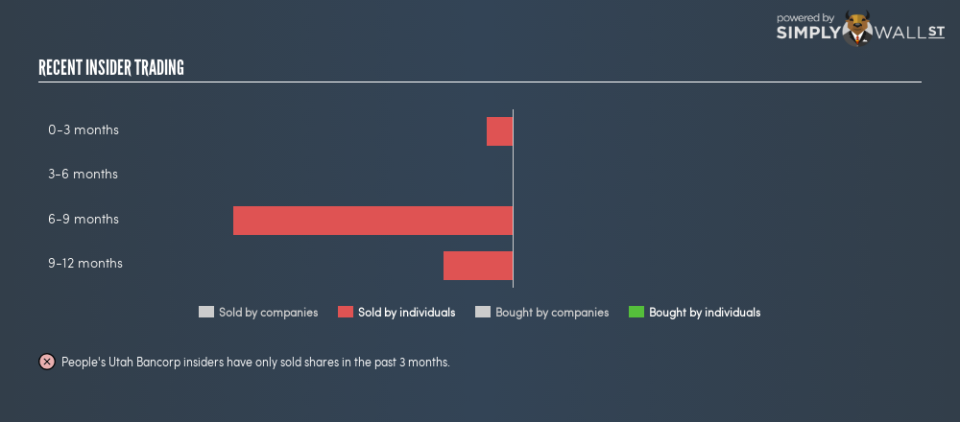Read This Before Buying People’s Utah Bancorp (NASDAQ:PUB) Shares

Want to participate in a short research study? Help shape the future of investing tools and you could win a $250 gift card!
It is not uncommon to see companies perform well in the years after insiders buy shares. Unfortunately, there are also plenty of examples of share prices declining precipitously after insiders have sold shares. So before you buy or sell People’s Utah Bancorp (NASDAQ:PUB), you may well want to know whether insiders have been buying or selling.
Do Insider Transactions Matter?
Most investors know that it is quite permissible for company leaders, such as directors of the board, to buy and sell stock on the market. However, most countries require that the company discloses such transactions to the market.
Insider transactions are not the most important thing when it comes to long-term investing. But it is perfectly logical to keep tabs on what insiders are doing. As Peter Lynch said, ‘insiders might sell their shares for any number of reasons, but they buy them for only one: they think the price will rise.’
See our latest analysis for People’s Utah Bancorp
People’s Utah Bancorp Insider Transactions Over The Last Year
Director Wolfgang T. Muelleck made the biggest insider sale in the last 12 months. That single transaction was for US$975k worth of shares at a price of US$32.28 each. That means that an insider was selling shares at around the current price of US$28.83. They might be selling for a variety of reasons, but it’s hard to argue this is a bullish sign. We usually pause to reflect on the potential that a stock has a high valuation, if insiders have been selling at around the current price.
We note that in the last year insiders divested 54.03k shares for a total of US$1.8m. All up, insiders sold more shares in People’s Utah Bancorp than they bought, over the last year. The sellers received a price of around US$32.44, on average. It’s not ideal to see that insiders have sold at around the current price. Since insiders sell for many reasons, we wouldn’t put too much weight on it. You can see a visual depiction of insider transactions (by individuals) over the last 12 months, below. By clicking on the graph below, you can see the precise details of each insider transaction!
If you like to buy stocks alongside management, then you might just love this free list of companies. (Hint: insiders have been buying them).
People’s Utah Bancorp Insiders Are Selling The Stock
Over the last three months, we’ve seen significant insider selling at People’s Utah Bancorp. In total, Director Paul Gunther dumped US$112k worth of shares in that time, and we didn’t record any purchases whatsoever. This may suggest that some insiders think that the shares are not cheap.
Insider Ownership
Another way to test the alignment between the leaders of a company and other shareholders is to look at how many shares they own. We usually like to see fairly high levels of insider ownership. It appears that People’s Utah Bancorp insiders own 12% of the company, worth about US$63m. While this is a strong but not outstanding level of insider ownership, it’s enough to indicate some alignment between management and smaller shareholders.
So What Do The People’s Utah Bancorp Insider Transactions Indicate?
An insider sold stock recently, but they haven’t been buying. And there weren’t any purchases to give us comfort, over the last year. But since People’s Utah Bancorp is profitable and growing, we’re not too worried by this. Insider ownership isn’t particularly high, so this analysis makes us cautious about the company. We’d think twice before buying! Therefore, you should should definitely take a look at this FREE report showing analyst forecasts for People’s Utah Bancorp.
If you would prefer to check out another company — one with potentially superior financials — then do not miss this free list of interesting companies, that have HIGH return on equity and low debt.
To help readers see past the short term volatility of the financial market, we aim to bring you a long-term focused research analysis purely driven by fundamental data. Note that our analysis does not factor in the latest price-sensitive company announcements.
The author is an independent contributor and at the time of publication had no position in the stocks mentioned. For errors that warrant correction please contact the editor at editorial-team@simplywallst.com.

